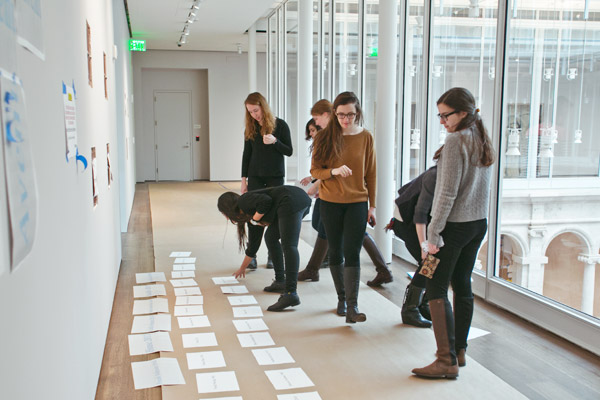It’s not every day that college students can add to a work by a world-renowned artist, but some Harvard undergraduates recently did just that with “Untitled” (Portrait of Michael Jenkins) (1991), a word portrait by Felix Gonzalez-Torres. The portrait examines the intersection of public and private events and how they shape individual lives. Mary Schneider Enriquez, Houghton Associate Curator of Modern and Contemporary Art, invited members of the museums’ Student Guide Program to brainstorm textual excerpts, share ideas about what constitutes society’s collective memory, and consider the relationship between the artist, the museums, and the subject of the portrait. Selected texts and dates from that session will become part of the portrait, which will be on display when we open in November.
Sarah Rosenthal (Harvard Class of 2015) recently shared her story of working on this innovative project:
When I walk into the Harvard Art Museums this fall, I will be able to see a work of art featuring contributions by a group of current Harvard students. The work, “Untitled” (Portrait of Michael Jenkins), by the late contemporary artist Felix Gonzalez-Torres, is a word portrait that will wrap around an arcade and will be written directly on the wall. Together with other student guides, I offered my thoughts on new text for the portrait, which can change each time it is installed. Visitors to the museums will undoubtedly wonder at the elusive meaning of the words, making the work as a whole all the more powerful.
The portrait, originally created in 1991, consists of a list of events, each of which has been boiled down to a few words or names and the year in which it occurred. The events include both private events selected by Michael Jenkins, who commissioned the work, and public events that Gonzalez-Torres himself chose. The string of text stands in as a portrait for Jenkins. Owners of the word portrait may add to, delete from, and rearrange the list of events each time they put it up for display. That’s where our group of students came in. Because the work will be installed in the new Harvard Art Museums, Harvard had the task of modifying the text and invited its student guides to contribute to that process.
We had read about this specific work and other Gonzalez-Torres word portraits before we met with Mary Schneider Enriquez, Houghton Associate Curator of Modern and Contemporary Art; Jessica Levin Martinez, director of the Division of Academic and Public Programs; and Erin Northington, student outreach and programs coordinator, to add text. It was a strange task, adding to a portrait of someone I’ve never met. It felt oddly invasive, which was probably part of the artist’s intent. The portrait acknowledges that each person’s life story encompasses a chain reaction of events beginning with a large-scale public event. By considering personal stories, though, one can also see how an individual’s life contributes to the larger picture of human history.
In that first meeting, we each recalled and shared events that had shaped our lives. Many of us told deeply personal stories that we narrowed down into shockingly brief (one to three words), evocative phrases. We played with pairing events that we had personally experienced with historical dates that those events recalled. By the end of the meeting, we had formulated our own list of words recalling public and private events. When we looked over the list, we saw substantive, life-defining words lose their meaning: they became as mysterious as the original text that defined a man whom none of us knows.
We all met again in the new Harvard Art Museums facility a few months later. The director’s office and curatorial staff had chosen the final list of events to add to the portrait. Now we had to decide on the order in which they should appear. We knew we didn’t want to put them in chronological order, but should we leave the arrangement to chance or order the events deliberately? Testing both approaches, we first pulled each event out at random to see what chance would create, and then created juxtapositions that most appealed to us. The process was fascinating; certain juxtapositions instantly clicked, while others seemed too obvious. Linguistic and conceptual echoes suddenly emerged where they had not appeared before: short, familiar words accompanied by longer foreign ones, and proper nouns next to those more common. In the end, we came up with a jumbled timeline—the public interwoven with the quiet, comfortable spaces of the private.
When the new Harvard Art Museums open in November, our words, together with those of Michael Jenkins and Felix Gonzalez-Torres, will line the entire third-floor arcade. Positioned above displays of ancient art, the word portrait will suggest a classical frieze. I’m excited to see the work this fall when its already puzzling content starts speaking to the other works around it.
Sarah Rosenthal (Harvard Class of 2015) is our Index student correspondent. She is concentrating in History of Art and Architecture, with a focus on Modern and Contemporary Art, and a secondary in Computer Science.
The other students involved in the collaborative process are seniors Camille Coppola, Kerry Qu, Lanier Walker, and Georgina Winthrop, and juniors Barbara Carvalho, Krystle Leung, Krithika Varagur, and Nora Wilkinson.
Support for the installation of “Untitled” (Portrait of Michael Jenkins), 1991, has been provided by the Dimitri Hadzi Memorial Fund for Modern Art at the Harvard Art Museums.


